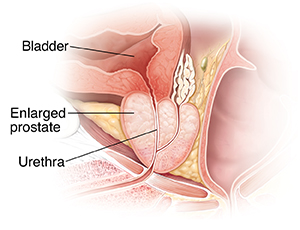Benign Prostatic Hyperplasia
The prostate is a small gland in men that makes a fluid that goes into semen. As you age, the prostate grows. If it becomes too big, it may cause problems with urination. This condition is called benign prostatic hyperplasia (BPH). BPH is not a cancer.

Symptoms of BPH
BPH is common in men older than age 60. That’s because the prostate grows bigger during a man’s life. As it grows, it presses against the urethra. The urethra is the tube that carries urine out of your body from your bladder through your penis. Your bladder may also weaken as you age. It may not empty completely after you urinate.
Men with BPH may have these symptoms:
-
The urge to frequently urinate, especially at night
-
Leaking or dribbling of urine
-
A weak stream of urine
-
Not able to urinate, or having trouble starting to urinate
Diagnosing BPH
BPH can hurt your bladder and kidneys. It can also lead to bladder stones, blood in the urine, and urinary tract infections. If you think you may have BPH, talk with your healthcare provider. Early treatment can prevent problems.
Several tests can diagnose BPH. These include:
-
Digital rectal exam. During this procedure, your provider puts a gloved, greased (lubricated) finger into your rectum to check the size of your prostate.
-
Imaging tests. X-rays and other imaging tests can find problems in your kidneys or bladder.
-
Cystoscopy. This test uses a flexible tube with a camera (called a scope). The scope is passed up the urethra to look inside your urinary tract.
-
Urine flow study. This test uses a special device to see how fast urine leaves your body.
-
Prostate ultrasound. This test uses sound waves to view the size and inside of the prostate gland.
Treating BPH
If you have mild symptoms, you may not need treatment. You may be able to control your BPH with lifestyle changes. Some men feel better if they limit or don't have alcohol and caffeinated drinks such as coffee. Not drinking too many fluids at night can also help. Increasing your physical activity may ease symptoms, too.
Kegel exercises may also help. They strengthen the pelvic muscle to prevent urine from leaking. Contract your pelvic muscles as if you were to stop or slow down the flow of urine. Hold for 10 seconds. Repeat at least 5 times. Do the exercise 3 to 5 times each day.
Certain medicines can worsen BPH symptoms. These include medicines for congestion, allergies, and depression. Medicines that increase your urine flow (diuretics or water pills) can also worsen BPH symptoms. If you take any of these, talk with your provider. You may need to take another medicine or change how much you take.
BPH symptoms often get worse as the prostate grows. So at some point you may need treatment. Your provider may prescribe medicine to shrink the prostate or stop its growth. Other treatments can make the urethra wider to let urine flow more easily. There are also some minimally invasive methods to remove prostate tissue.
If your BPH is severe, your healthcare provider may advise surgery. Surgery takes out enlarged parts of the prostate gland. You and your provider can figure out the best option for you based on your age, overall health, and other factors.
BPH and prostate cancer
BPH and prostate cancer share some symptoms and may occur at the same time. That’s why it’s important to talk with your provider about your symptoms. Men with BPH don't have cancer. But they may have higher levels of prostate-specific antigen (PSA). A higher PSA level may also be a sign of prostate cancer. Certain tests help tell BPH from prostate cancer. They include prostate ultrasound and biopsy.